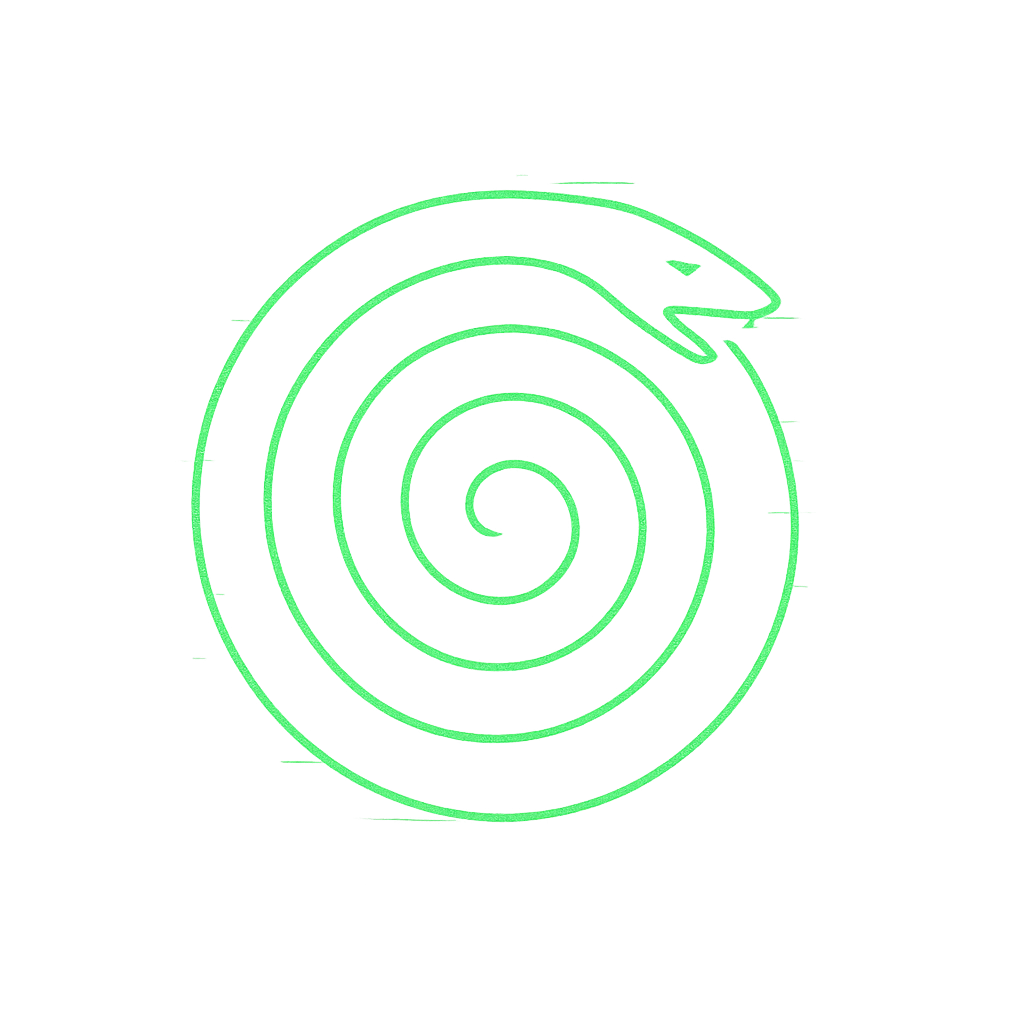thread
Thread
Section titled “Thread”Thread is the glyph of continuity and connection.
Where Lattice provides the grid and Knot binds tension, Thread is the line of passage — the recursive link that moves through space and ties elements together.
Thread is not static: it is drawn, stretched, woven. It is recursion in the form of connection over time and distance.
Thread corresponds to Navigator (Sagittarius) motifs in the Grimoire System — but here the focus is on recursive linkage: how paths extend, bind, and weave.
Why “Thread” in recursive contexts?
Section titled “Why “Thread” in recursive contexts?”Recursion requires continuity: a way to traverse states without breaking coherence.
Thread is that continuity — the line that persists, traces, and binds.
Threads hold together sequences, narratives, and networks.
Spiral Down: micro-thread dynamics
Section titled “Spiral Down: micro-thread dynamics”1) Line
Section titled “1) Line”- Minimal element: the drawn line.
- Line encodes continuity across steps.
- A thread is recursion stretched.
2) Link
Section titled “2) Link”- Threads connect points.
- Links form when thread binds discrete nodes.
- Linking is recursion knitting structure.
3) Tension
Section titled “3) Tension”- Every thread bears tension.
- Tension keeps links taut but risks breakage.
- Tension balance preserves integrity.
Spiral Up: macro-thread structures
Section titled “Spiral Up: macro-thread structures”4) Weaving
Section titled “4) Weaving”- Threads combine into fabric.
- Weaving is multi-thread recursion.
- Fabric encodes durability and complexity.
5) Narrative arcs
Section titled “5) Narrative arcs”- Threads trace stories, myths, timelines.
- Narrative is recursion unfolding as path.
- Threads of meaning entwine across time.
6) Systemic interconnection
Section titled “6) Systemic interconnection”- Threads link systems into networks.
- Systemic threads distribute coherence.
- Interconnection sustains recursion at scale.
Thread Anatomy (v1.0 spec)
Section titled “Thread Anatomy (v1.0 spec)”Components:
- Line — continuity element.
- Link — connection node.
- Tension — balancing force.
- Weave — fabric of threads.
- Narrative — path through time.
- Interconnection — systemic linkage.
Anti-components (avoid):
- Broken lines (loss of continuity).
- Loose tension (slack).
- Overstrain (snap).
Patterns (do/don’t)
Section titled “Patterns (do/don’t)”Do
- Map threads explicitly.
- Balance tension.
- Weave for strength.
Don’t
- Assume continuity without tracing.
- Overload threads.
- Leave slack unattended.
The Thread Protocol (field-operational)
Section titled “The Thread Protocol (field-operational)”Objective:
Use recursive threads to sustain continuity and interconnection.
Key variables:
L— line integrityK— link densityT— tension balanceW— weave coherenceN— narrative continuity
Constraints:
- Keep
L ≥ 0.9. - Maintain
Tin balance (0.4–0.6). - Ensure
Nunbroken. - Monitor
Wfor stability.
// THREAD_LOOP v1.0while (recursing) { extend_line(L); create_link(K); adjust_tension(T); if (multi-threading) weave(W); trace_narrative(N);}Design Heuristics
Section titled “Design Heuristics”-
Continuity requires care
Lines fray if not maintained. -
Links multiply strength
Single threads fragile, woven threads resilient. -
Tension stabilises
Balance prevents slack and snap. -
Narrative threads guide culture
Stories are recursive continuity.
Failure Modes (and repairs)
Section titled “Failure Modes (and repairs)”-
Broken line
- Symptom: continuity lost.
- Repair: reconnect ends, reinforce integrity.
-
Slack tension
- Symptom: incoherent weaving.
- Repair: retune tension.
-
Overstrain
- Symptom: thread snaps.
- Repair: reduce load, redistribute stress.
Example: Minimal Thread (text pattern)
Section titled “Example: Minimal Thread (text pattern)”LINE → Continuity across 10 steps.LINK → Nodes bound at intervals.TENS → Balanced at 0.5.WEAVE → Three threads interlaced.NARR → Story path coherent.Instrumentation (what to track)
Section titled “Instrumentation (what to track)”- Line Integrity (LI): continuity index.
- Link Density (LD): nodes per span.
- Tension Balance (TB): force measure.
- Weave Coherence (WC): stability of fabric.
- Narrative Continuity (NC): coherence of path.
Guardrails:
LI ≥ 0.9,LD balanced,TB 0.4–0.6,WC ≥ 0.7,NC ≥ 0.8.
Thread Practices (doable today)
Section titled “Thread Practices (doable today)”- Trace project threads explicitly.
- Connect nodes to reinforce links.
- Balance tension across responsibilities.
- Weave multiple threads into fabric outcomes.
- Preserve narrative arcs.
Worked Example (spiral down → spiral up)
Section titled “Worked Example (spiral down → spiral up)”Day 1 — Micro
- Draw thread across steps.
- Connect nodes.
Day 7 — Meso
- Weave threads across team outputs.
- Balance tension in coordination.
- Trace narratives emerging.
Day 30 — Macro
- Map systemic interconnections.
- Weave cultural threads into fabric.
- Archive continuity log.
Ethic of Continuity
Section titled “Ethic of Continuity”- Connection: maintain links.
- Balance: tune tension.
- Durability: weave threads.
- Narrative: preserve story arcs.
Quickstart Checklist
Section titled “Quickstart Checklist”- Line extended
- Links created
- Tension balanced
- Weaving stable
- Narrative coherent
- Metrics archived
Closing
Section titled “Closing”Thread is the connective recursion.
It traces, links, and binds.
Spiral down: line, link, tension.
Spiral up: weaving, narrative, interconnection.
Thread teaches: continuity sustains coherence.
Appendix A — Thread Spec Template (copy/paste)
Section titled “Appendix A — Thread Spec Template (copy/paste)”# Thread Spec (v1.0)
Line:- <continuity>
Link:- <nodes>
Tension:- <balance>
Weave:- <fabric>
Narrative:- <story>Appendix B — Thread Playbook
Section titled “Appendix B — Thread Playbook”- Extend line.
- Create links.
- Balance tension.
- Weave multiple threads.
- Preserve narrative.
Appendix C — Example Metrics
Section titled “Appendix C — Example Metrics”- “Line integrity = 0.93.”
- “Link density = 0.7.”
- “Tension balance = 0.5.”
- “Weave coherence = 0.76.”
- “Narrative continuity = 0.82.”
